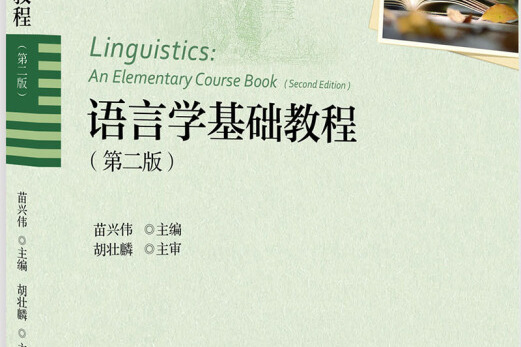《語言學基礎教程(第二版)》是2018年北京大學出版社出版的圖書,作者是苗興偉。
基本介紹
- 中文名:語言學基礎教程(第二版)
- 作者:苗興偉
- 出版社:北京大學出版社
- 出版時間:2018年8月1日
- 裝幀:平裝
- ISBN:9787301296585
編輯推薦,內容簡介,圖書目錄,作者簡介,
編輯推薦
《語言學基礎教程》(第二版)力求以通俗易懂的語言和內容將語言學知識呈獻給讀者,章節安排循序漸進,知識體系完整,有助於語言學學習者在掌握語言學理論的基礎上進一步拓展知識領域,培養創新能力和套用能力,提高綜合素養。
內容簡介
《語言學基礎教程(第二版)》包括語言與語言學、語音學與音位學、形態學、句法學、語義學、語用學、語篇分析、歷史語言學、文體學、社會語言學、跨文化交際、心理語言學、認知語言學、套用語言學等十四章。該書在傳授基本知識與概念的同時,通過豐富的實例提供了有關語言分析和描述的基本方法,並強調語言學與其他學科的聯繫,以便適應創新型人才培養的需要。在修訂過程中,除了修改了語言表達方面的細節問題,重點對第六章、第七章和第十三章的內容做了修訂。第六章主要增加了對理論的解釋,以幫助學生更好地把握語用學的理論。第七章增加了批評話語分析的內容,以反映語篇分析的發展和前沿。第十三章增加了“語法化和辭彙化”一節,目的使學生了解語法化和辭彙化及其背後的認知機制。為使學生鞏固所學知識並進一步學習有關知識,拓展語言學學習和研究的空間,每章增加了“深入閱讀”(further reading)書單。其他方面的修訂就不一一介紹了,希望修訂版的《語言學基礎教程》能以全新的面目出現在大家的面前,更好地滿足廣大的語言學教師、學習者和愛好者的需要。我們真誠地期待讀者的鼓勵和反饋,希望《語言學基礎教程》在大家的幫助下不斷成長。
圖書目錄
CONTENTS
Chapter 1 Language and Linguistics
1.1What is Language
1.2The Design Features of Language
1.3The Origin of Language
1.4What is Linguistics
1.5The Scope of Linguistics
1.6A Brief History of Linguistics
Chapter 2Phonetics and Phonology: The Sounds and Sound Patterns of Language
2.1Introduction
2.2Phonetics
2.3Phonology
2.4Summary
Chapter 3Morphology: The Word Structure of Language
3.1Introduction
3.2The Words of Language
3.3The Structure of Words
3.4Morpheme, Morph and Allomorph
3.5Classification of Morphemes
3.6Word Formation Processes
3.7Summary
Chapter 4Syntax: The Sentence Structure of Language
4.1Introduction
4.2Sentence Structure
4.3The Traditional Approach
4.4The Structural Approach
4.5The Transformationalgenerative Approach
4.6The Functional Approach
4.7Summary
Chapter 5Semantics: The Meaning of Language
5.1Introduction
5.2Approaches to Meaning
5.3Sense and Reference
5.4Word Meaning
5.5Sentence Meaning
5.6Ambiguity
5.7Semantic Analysis
Chapter 6Pragmatics: The Use of Language in Context
6.1Introduction
6.2Pragmatics as a New Branch of Linguistics
6.3Speech Act Theory
6.4Theory of Conversational Implicature
6.5Politeness Principle
6.6Summary
Chapter 7Discourse Analysis: Language Above the Sentence
7.1Introduction
7.2What is Discourse Analysis
7.3Cohesion
7.4Coherence
7.5The Structure of Discourse
7.6Critical Discourse Analysis
7.7Conclusion
Chapter 8Historical Linguistics: Language through Time
8.1Introduction
8.2When Language Changes
8.3How Language Changes
8.4Why Language Changes
8.5Summary
Chapter 9Stylistics: Language and Literature
9.1Introduction
9.2Important Views on Style
9.3Stylistic Analysis
Chapter 10Sociolinguistics: Language and Society
10.1Introduction
10.2The Relations Between Language and Society
10.3Speech Community and Speech Variety
10.4Dialect
10.5Register
10.6Language Contact and Contact Languages
10.7Choosing a Code
Chapter 11Intercultural Communication: Language and Culture
11.1Introduction
11.2Definitions of Culture
11.3The Relationship Between Language and Culture
11.4Naming the World Through Language
11.5Communicative Patterns Across Cultures
11.6Language and Thought: SapirWhorf Hypothesis
11.7Intercultural Communication
11.8Summary
Chapter 12Psycholinguistics: Language and Psychology
12.1Introduction
12.2Language and the Brain: The Biological Foundations of Language
12.3Language Comprehension
12.4Language Production
12.5Language Acquisition
Chapter 13Cognitive Linguistics: Language and Cognition
13.1Introduction
13.2Categories and Categorization
13.3Conceptual Metaphors
13.4Conceptual Metonymies
13.5Image Schemas
13.6Iconicity
13.7Grammaticalization and Lexicalization
Chapter 14Applied Linguistics: Language Teaching and Learning
14.1Introduction
14.2How is Language Learned?
14.3Individual Differences in Language Learning
14.4Approaches and Methods in Foreign Language Teaching
14.5Language Testing
References
Glossary
作者簡介
苗興偉,北京師範大學外國語學院副院長、博士生導師,教育部新世紀優秀人才。主要從事功能語言學、語用學、語篇分析、文體學和語言教學研究。

